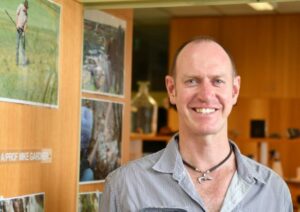The fragmentation of lizard populations millions of years ago could spell trouble with continued climate change.
A new way of looking at the impact humans have on species from a Global Systems angle, suitable for delivery alongside the Earth and Sciences Curriculum for year 10 or Biological Sciences curriculum for years 7 or 9.
Word Count: 429

The fragmentation of lizard habitat across Australia brought about by Ice Age aridification millions of years ago could lead to smaller current populations having a reduced ability to cope with continued climate change, say Flinders University researchers.
Studies into populations of the Australian scincid lizard, Tiliqua rugosa (commonly known as the Sleepy Lizard, or Shingleback Lizard) has identified a prehistoric case study that shows climate change had a significant effect on genetic differences in this native animal species.
This tumultuous history has been published in the journal Molecular Phylogenetics and Evolution by Mike Gardiner, continuing investigations into lizard behaviour that was commenced by the late Professor Mike Bull.
Fragmentation of lizard populations across Australia
Molecular clock analyses suggest that the diversification of Australia’s lizard populations occurred in the Plio-Pleistocene epoch, which began about 5 million years ago.
Before this last glacial maximum, the Tiliqua rugosa species and others were likely to be found in multiple suitable areas across Australia rather than all retreating to a single suitable region.
However, the creation of geographic barriers –the Nullarbor region and the presence of a vast historic lake (Bungunnia) – resulted in large genetic differences occurring between lizard populations that became isolated on either side of the Nullarbor Plain, and either side of the Murray River.
Continued habitat fragmentation across Australia provides a significant threat to current lizard populations, because ensuring adequate geneflow among the species requires their free movement beyond existing geographic barriers.
“Solving this problem can be facilitated by establishing vegetation corridors between the different regions, which would help to ensure the mobility and conservation of these populations,” says Flinders University molecular ecologist Associate Professor Mike Gardner.

“This problem represents a bigger picture about what is happening to species, and underlines that species survival depends on ensuring the maintenance of long-term genetic diversity.
“It highlights that we have seen such dramatic change to the landscape – and it continues to change at an accelerating pace. Species simply can’t have the same levels of genetic diversity that they had in the past.”
Herpetologist Associate Professor Gardner says Flinders’ continuing research into the genetics of Australian lizard populations illustrates the heightened need for animal refuge habitats to protect the future of existing species.
“It’s vitally important to maintain historical refuge areas, which must become a priority of land managers,” he says.
Work continues in the longest-running lizard research in the Southern Hemisphere. With costs around $50,000 each year, for field work and other expenses, the Flinders University scientists rely on the generous support of the community who can give to the dedicated alumni appeal.
For details about the program and to give a donation visit the website.
Login or Sign up for FREE to download a copy of the full teacher resource





